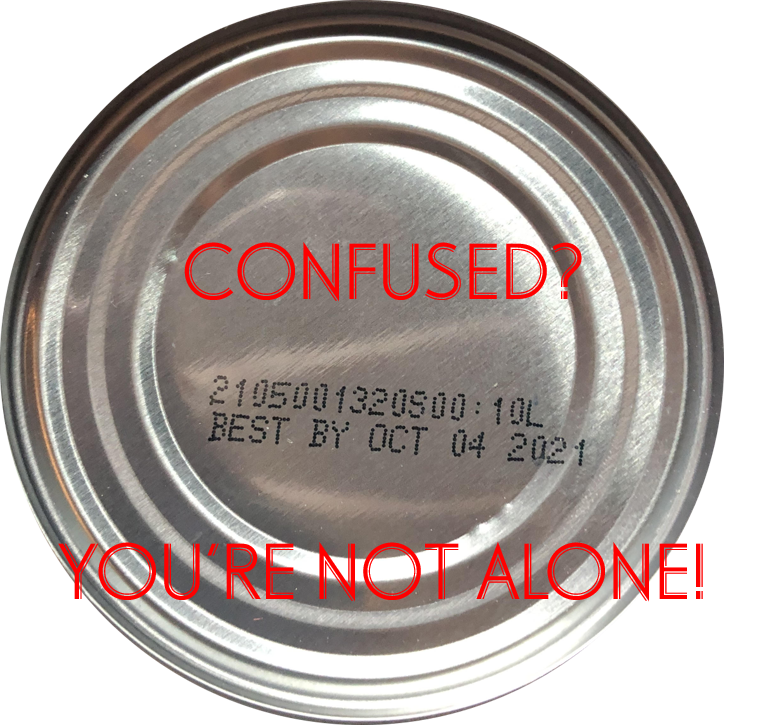You may have watched a History Channel reality show entitled “Eating History.” During each episode, the show’s stars, Old Smokey and Josh Macuga, explore history through old foods that have survived for a long time. In other words, they simply ignore the “sell by” dates found on old products and eat them. To date, they have survived. Everyday normal people also ignore “sell by” dates hoping they won’t get sick or die. Bethany Moncel (@Budget_Bytes), a cook and freelance journalist, reports, “Packaged foods often include a printed calendar date that is identified by the words Sell By, Use By, or Best Used By. Consumers often imagine that these dates are a legal requirement, but in reality, only baby formula has any such federally mandated requirements for dating food.”[1] Although food safety is a real concern, so is food waste. A study, conducted by researchers from various departments in the University of Maryland’s College of Agriculture & Natural Resources, concluded, “Food is lost or wasted at different stages of the food production, consumption, and supply chain. Confusion over the interpretation of date labels at the retail and consumption stages results in consumers discarding safe, wholesome, and good quality food, which contribute significantly to the global food waste. Yet, there is a lack of research in understanding the association between food waste and date labeling worldwide.”[2]
Label confusion
One of the University of Maryland researchers, Debasmita Patra, notes, “We have 50 different types of date labels that are currently used in the US because there is no regulation — best by, best if used by, use by — and we as consumers don’t know what these things mean. The labeling is the manufacturer’s best estimation based on taste or whatever else, and it is not scientifically proven. But our future intention is to scientifically prove what is the best way to label foods. As a consumer and as a mom, a best by date might raise food safety concerns, but date labeling and food safety are not connected to each other right now, which is a wide source of confusion. And when billions of dollars are just going to the trash because of this, it’s not a small thing.”[3] As Moncel notes, “These dates are simply ‘suggestions’ from manufacturers as to a time frame for experiencing the best quality from the product.”
According to the U.S. Department of Agriculture (USDA), “Two types of product dating may be shown on a product label. ‘Open Dating’ is a calendar date applied to a food product by the manufacturer or retailer. The calendar date provides consumers with information on the estimated period of time for which the product will be of best quality and to help the store determine how long to display the product for sale. ‘Closed Dating’ is a code that consists of a series of letters and/or numbers applied by manufacturers to identify the date and time of production. … For meat, poultry, and egg products under the jurisdiction of the Food Safety and Inspection Service (FSIS), dates may be voluntarily applied provided they are labeled in a manner that is truthful and not misleading and in compliance with FSIS regulations. To comply, a calendar date must express both the month and day of the month. In the case of shelf-stable and frozen products, the year must also be displayed. Additionally, immediately adjacent to the date must be a phrase explaining the meaning of that date such as ‘Best if Used By’.”[4]
Food Safety versus Food Wastage
Since “sell by” or “use by” dates are voluntary, manufacturers are free to determine how dates should be established. The USDA notes factors for determining sell by dates include the length of time and the temperature at which a food is held during distribution and offered for sale, the characteristics of the food, and the type of packaging used. The USDA concludes, “Manufacturers and retailers will consider these factors when determining the date for which the product will be of best quality.” On the other, the USDA notes, “These products will typically maintain product quality for a longer period of time because of how the products are formulated or packaged. The quality of perishable products may deteriorate after the date passes; however, such products should still be safe if handled properly. Consumers must evaluate the quality of the product prior to its consumption to determine if the product shows signs of spoilage.” There you have it. Consumers are being asked to be just like Old Smokey and Josh Macuga and determine whether or not they should eat foods whose “sell by” or “use by” dates have passed.
The USDA goes on to note, “USDA estimates that 30 percent of the food supply is lost or wasted at the retail and consumer levels. One source of food waste arises from consumers or retailers throwing away wholesome food because of confusion about the meaning of dates displayed on the label. To reduce consumer confusion and wasted food, FSIS recommends that food manufacturers and retailers that apply product dating use a ‘Best if Used By’ date. Research shows that this phrase conveys to consumers that the product will be of best quality if used by the calendar date shown. Foods not exhibiting signs of spoilage should be wholesome and may be sold, purchased, donated and consumed beyond the labeled ‘Best if Used By’ date. … In an effort to reduce food waste, it is important that consumers understand that the dates applied to food are for quality and not for safety. Food products are safe to consume past the date on the label, and regardless of the date, consumers should evaluate the quality of the food product prior to its consumption.”
How big of a problem is food waste? It’s a big problem. The staff at Quality Assurance Magazine reports, “Americans discard or waste about 133 billion pounds of food each year, representing $161 billion and a 31% loss of food at the retail and consumer level. According to FDA, 90% of Americans say they are likely to prematurely discard food because they misinterpret date labels because of food safety concerns or uncertainty on how to properly store the product. This simple confusion accounts for 20% of the total annual food waste in the United States, representing more than 26 billion pounds per year and over $32 billion in food waste.”[5]
Abani Pradhan, another co-author of the University of Maryland paper, indicates hope may be on the way for confused consumers. “We aim to scientifically evaluate the quality characteristics, shelf life, and food spoilage risk of food products,” Pradhan said. “This would help in determining if the food products are of good quality beyond the mentioned dates, rather than discarding them prematurely. We anticipate to reduce food waste through our ongoing and future research findings.” According to Pradhan, both experimental and mathematical modeling will play a role in future studies. I suspect most consumers would be interested in knowing their food is safe as well as being of the highest quality. Since some shelf-stable foods that have passed are donated to food banks, knowing food is safe to distribute should be a concern for everyone — including government officials.
Concluding thoughts
Patra observes, “Food is something that is involved in everybody’s life, and so everyone needs to be a good food manager. But even now, there is no robust scientific evidence behind date labels, and yet those labels govern people’s purchasing behavior. People look for something that has a longer ‘best by’ date thinking they are getting something better. And when you throw that food away, you are not only wasting the food, but also all the economics associated with that, like production costs, transportation from the whole farm to fork chain, and everything else that brought you that product just to be thrown away. Food safety, regulation, and education need to all combine to help solve this problem, which is why interdisciplinary collaboration is so important.” I couldn’t agree more.
Footnotes
[1] Bethany Moncel, “‘Sell by’ and ‘Best Used By’ Labels on Food Packaging,” The Spruce Eats, 2 May 2019.
[2] Debasmita Patra, Paul T. Leisnham, Collins K. Tanui, and Abani K. Pradhan, “Evaluation of global research trends in the area of food waste due to date labeling using a scientometrics approach,” ScienceDirect, September 2020.
[3] Staff, “UMD Researchers Seek to Establish the Science Behind Date Labeling,” Quality Assurance Magazine, 19 May 2020.
[4] Staff, “Food Product Dating,” U.S. Department of Agriculture.
[5] Quality Assurance Magazine, op. cit.





